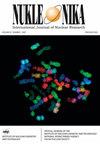欧洲相互比较研究作为完善辐照食品检测方法的工具
IF 0.3
4区 物理与天体物理
Q4 CHEMISTRY, INORGANIC & NUCLEAR
引用次数: 2
摘要
摘要:本文介绍了1991年至2018年欧洲领先实验室对辐照食品鉴定进行的相互比较研究的结果。20世纪90年代,德国联邦消费者健康保护和兽医研究所在组织关于这一主题的实验室间测试方面发挥了主导作用。在本世纪初,西班牙食品安全和营养署和西班牙国家食品中心接管了这一职能。总共进行了47项国际测试,其中来自14个欧洲国家的37个实验室分析了近500个食品样品。这些测试旨在证明分析方法——热释光(TL)、光激发发光(PSL)和电子顺磁共振(EPR)光谱——用于识别特定辐照食品的可靠性,并控制参与实验室的分析技能和经验。这一结果使我们有可能讨论为什么一些辐照食品样品更难识别。总的来说,这些测试表明,对草药、坚果、辣椒和葡萄干等产品的辐射强度测量,以及对鱼和鸡骨头、新鲜草莓和干果的辐射强度研究,都可以作为可靠的控制方法。控制实验室现在面临的挑战,是与复杂食品的鉴定有关,如膳食补充剂或生物制药,其中只有一些添加剂被辐照。本文章由计算机程序翻译,如有差异,请以英文原文为准。
European inter-comparison studies as a tool for perfecting irradiated food detection methods
Abstract In this paper, we present the results of inter-comparison studies on identification of irradiated food carried out by the leading European laboratories from 1991 to 2018. In 1990s, the Federal Institute for Health Protection of Consumers and Veterinary Medicine in Germany played the leading role in the organization of the inter-laboratory tests on this subject. At the beginning of the present century, the Spanish Agency for Food Safety and Nutrition and Food National Spanish Centre took over this role. In total, 47 international tests were carried out in which nearly 500 samples of alimentary products were analysed in 37 laboratories from 14 European countries. The tests were aimed at proving the reliability of analytical methods – thermoluminescence (TL), photostimulated luminescence (PSL), and electron paramagnetic resonance (EPR) spectroscopy – for identification of specific irradiated food products and to control the analytical skills and experience of participating laboratories. The results made possible a discussion on why some irradiated food samples are more difficult for identification. In general, the tests showed that TL measurements of products such as herbs, nuts, peppers, and raisins, and EPR studies of fish and chicken bones, fresh strawberries, and dried fruits could be used as reliable control methods. The challenge that control laboratories are facing now, is related to the identification of complex food products such as diet supplements or biopharmaceuticals, in which only some additives are irradiated.
求助全文
通过发布文献求助,成功后即可免费获取论文全文。
去求助
来源期刊

Nukleonika
物理-无机化学与核化学
CiteScore
2.00
自引率
0.00%
发文量
5
审稿时长
4-8 weeks
期刊介绍:
"Nukleonika" is an international peer-reviewed, scientific journal publishing original top quality papers on fundamental, experimental, applied and theoretical aspects of nuclear sciences.
The fields of research include:
radiochemistry, radiation measurements, application of radionuclides in various branches of science and technology, chemistry of f-block elements, radiation chemistry, radiation physics, activation analysis, nuclear medicine, radiobiology, radiation safety, nuclear industrial electronics, environmental protection, radioactive wastes, nuclear technologies in material and process engineering, radioisotope diagnostic methods of engineering objects, nuclear physics, nuclear reactors and nuclear power, reactor physics, nuclear safety, fuel cycle, reactor calculations, nuclear chemical engineering, nuclear fusion, plasma physics etc.
 求助内容:
求助内容: 应助结果提醒方式:
应助结果提醒方式:


